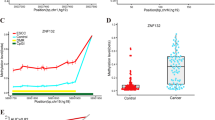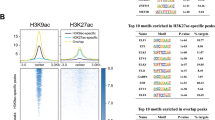Abstract
Background
Histone methylations are generally considered to play an important role in multiple cancers by regulating cancer-related genes.
Aims
This study aims to investigate the effects of H3K27me3-mediated inactivation of tumor suppressor gene SFRP1 and its function in esophageal squamous cell carcinoma (ESCC).
Methods
We performed ChIP-seq on H3K27me3-enriched genomic DNA fragments in ESCC cells to screen out tumor suppressor genes that may be regulated by H3K27me3. ChIP-qPCR and Western blot were employed to explore the regulating mechanisms between H3K27me3 and SFRP1. Expression level of SFRP1 was assessed by quantitative real-time polymerase chain reaction (q-PCR) in 29 pairs of ESCC surgical samples. SFRP1 function in ESCC cells were detected by cell proliferation assay, colony formation assay and wound-healing assay.
Results
Our results indicated that H3K27me3 was widely distributed in the genome of ESCC cells. Specifically, we found that H3K27me3 deposited on the upstream region of SFRP1 promoter and inactivated SFRP1 expression. Furthermore, we found SFRP1 was significantly down-regulated in ESCC tissues compared with the adjacent non-tumor tissues, and SFRP1 expression was significantly associated with TNM stage and lymph node metastasis. In vitro cell-based assay indicated that over-expression of SFRP1 significantly suppressed cell proliferation and negatively correlated with the expression of β-catenin in the nucleus.
Conclusions
Our study revealed a previously unrecognized finding that H3K27me3-mediated SFRP1 inhibit the cell proliferation of ESCC through inactivation of Wnt/β-catenin signaling pathway.







Similar content being viewed by others
References
Sung H, Ferlay J, Siegel RL et al. Global Cancer Statistics 2020: GLOBOCAN estimates of incidence and mortality worldwide for 36 cancers in 185 countries. CA: A Cancer Journal for Clinicians 2021;71:209–249.
Cao W, Chen HD, Yu YW, Li N, Chen WQ. Changing profiles of cancer burden worldwide and in China: a secondary analysis of the global cancer statistics 2020. Chinese Medical Journal 2021;134:783–791.
DiSiena M, Perelman A, Birk J, Rezaizadeh H. Esophageal cancer: an updated review. Southern Medical Journal 2021;114:161–168.
Hirano H, Kato K. Systemic treatment of advanced esophageal squamous cell carcinoma: chemotherapy, molecular-targeting therapy and immunotherapy. Japanese Journal of Clinical Oncology 2019;49:412–420.
Ilango S, Paital B, Jayachandran P, Padma PR, Nirmaladevi R. Epigenetic alterations in cancer. Frontiers in Bioscience (Landmark Edition) 2020;25:1058–1109.
Rothbart SB, Strahl BD. Interpreting the language of histone and DNA modifications. Biochimica et Biophysica Acta 2014;1839:627–643.
Esteller M. Cancer epigenomics: DNA methylomes and histone-modification maps. Nature Reviews Genetics 2007;8:286–298.
Audia JE, Campbell RM. Histone modifications and cancer. Cold Spring Harbor Perspectives in Biology 2016;8:a019521.
Wong SH, Goode DL, Iwasaki M et al. The H3K4-methyl epigenome regulates leukemia stem cell oncogenic potential. Cancer Cell 2015;28:198–209.
Katoh H, Qin ZS, Liu R et al. FOXP3 orchestrates H4K16 acetylation and H3K4 trimethylation for activation of multiple genes by recruiting MOF and causing displacement of PLU-1. Molecular Cell 2011;44:770–784.
Dubuc AM, Remke M, Korshunov A et al. Aberrant patterns of H3K4 and H3K27 histone lysine methylation occur across subgroups in medulloblastoma. Acta neuropathologica 2013;125:373–384.
Moena D, Nardocci G, Acevedo E et al. Ezh2-dependent H3K27me3 modification dynamically regulates vitamin D3-dependent epigenetic control of CYP24A1 gene expression in osteoblastic cells. Journal of Cellular Physiology 2020;235:5404–5412.
Qin WX, Shi Y, Zhu D et al. EZH2-mediated H3K27me3 enrichment on the lncRNA MEG3 promoter regulates the growth and metastasis of glioma cells by regulating miR-21-3p. European Review for Medical and Pharmacological Sciences 2020;24:3204–3214.
Krishnamurthy N, Kurzrock R. Targeting the Wnt/beta-catenin pathway in cancer: update on effectors and inhibitors. Cancer Treatment Reviews 2018;62:50–60.
Monga SP. β-catenin signaling and roles in liver homeostasis, injury, and tumorigenesis. Gastroenterology 2015;148:1294–1310.
Wang P, Li L, Li T. Positive correlation of cysteine-rich 61 and target genes of Wnt/β-catenin pathway in esophageal squamous cell carcinoma. Journal of Cancer Research and Therapeutics 2016;12:19–22.
Song Y, Li L, Ou Y et al. Identification of genomic alterations in oesophageal squamous cell cancer. Nature 2014;509:91–95.
Sawada G, Niida A, Uchi R et al. Genomic landscape of esophageal squamous cell carcinoma in a Japanese population. Gastroenterology 2016;150:1171–1182.
Lin S, Zhou M, Li Y et al. H3K27 trimethylation and H3K9 dimethylation as poor prognostic markers for patients with esophageal squamous cell carcinoma. International Journal of Clinical and Experimental Pathology 2019;12:2657–2664.
Sanchez-Vega F, Mina M, Armenia J et al. Oncogenic signaling pathways in the cancer genome atlas. Cell 2018;173:321-337.e310.
Yan KS, Lin CY, Liao TW et al. EZH2 in cancer progression and potential application in cancer therapy: a friend or foe? International Journal of Molecular Sciences 2017;18:1172.
Willert K, Jones KA. Wnt signaling: is the party in the nucleus? Genes & Development 2006;20:1394–1404.
Zhou YX, Liu Q, Wang H, Ding F, Ma YQ. The expression and prognostic value of SOX2, β-catenin and survivin in esophageal squamous cell carcinoma. Future Oncology (London, England) 2019;15:4181–4195.
Yu VZ, Ko JMY, Ning L, Dai W, Law S, Lung ML. Endoplasmic reticulum-localized ECM1b suppresses tumor growth and regulates MYC and MTORC1 through modulating MTORC2 activation in esophageal squamous cell carcinoma. Cancer Letters 2019;461:56–64.
Wang MT, Chen G, An SJ et al. Prognostic significance of cyclinD1 amplification and the co-alteration of cyclinD1/pRb/ppRb in patients with esophageal squamous cell carcinoma. Diseases of the Esophagus: Official Journal of the International Society for Diseases of the Esophagus 2012;25:664–670.
Siegel RL, Miller KD, Fuchs HE, Jemal A. Cancer statistics, 2021. CA: A Cancer Journal for Clinicians 2021;71:7–33.
Zhang Y, Sun Z, Jia J et al. Overview of histone modification. Advances in Experimental Medicine and Biology 2021;1283:1–16.
Schübeler D. Function and information content of DNA methylation. Nature 2015;517:321–326.
Liu X, Fu J, Bi H et al. DNA methylation of SFRP1, SFRP2, and WIF1 and prognosis of postoperative colorectal cancer patients. BMC Cancer 2019;19:1212.
Jeong YJ, Jeong HY, Bong JG, Park SH, Oh HK. Low methylation levels of the SFRP1 gene are associated with the basal-like subtype of breast cancer. Oncology Reports 2013;29:1946–1954.
Atschekzei F, Hennenlotter J, Jänisch S et al. SFRP1 CpG island methylation locus is associated with renal cell cancer susceptibility and disease recurrence. Epigenetics 2012;7:447–457.
Yoo KH, Hennighausen L. EZH2 methyltransferase and H3K27 methylation in breast cancer. International Journal of Biological Sciences 2012;8:59–65.
Zhou M, Li Y, Lin S et al. H3K9me3, H3K36me3, and H4K20me3 expression correlates with patient outcome in esophageal squamous cell carcinoma as epigenetic markers. Digestive Diseases and Sciences 2019;64:2147–2157.
Liu C, Li N, Lu H et al. Circulating SFRP1 promoter methylation status in gastric adenocarcinoma and esophageal square cell carcinoma. Biomedical Reports 2015;3:123–127.
Sumithra B, Saxena U, Das AB. Alternative splicing within the Wnt signaling pathway: role in cancer development. Cellular Oncology (Dordrecht). 2016;39:1–13.
Funding
This research was supported by the Open Project Program of the Key Laboratory of Developmental Genes and Human Diseases, Ministry of Education, China (Grant No. LDGHD202102).
Author information
Authors and Affiliations
Contributions
MZ: Formal analysis, Funding acquisition, Resources, Writing—original draft, Writing—review & editing. SY: Data curation, Investigation, Methodology. YL: Validation. SS: Data curation. YX: Software. ML: Validation. YG: Visualization. HF: Conceptualization, Project administration, Supervision.
Corresponding author
Ethics declarations
Conflict of interest
We declare that we do not have any commercial or associative interest that represents a conflict of interest in connection with the work submitted.
Additional information
Publisher's Note
Springer Nature remains neutral with regard to jurisdictional claims in published maps and institutional affiliations.
Supplementary Information
Below is the link to the electronic supplementary material.

Rights and permissions
Springer Nature or its licensor (e.g. a society or other partner) holds exclusive rights to this article under a publishing agreement with the author(s) or other rightsholder(s); author self-archiving of the accepted manuscript version of this article is solely governed by the terms of such publishing agreement and applicable law.
About this article
Cite this article
Zhou, M., Yu, S., Liu, Y. et al. H3K27me3 Inactivates SFRP1 to Promote Cell Proliferation via Wnt/β-Catenin Signaling Pathway in Esophageal Squamous Cell Carcinoma. Dig Dis Sci 68, 2463–2473 (2023). https://doi.org/10.1007/s10620-023-07892-7
Received:
Accepted:
Published:
Issue Date:
DOI: https://doi.org/10.1007/s10620-023-07892-7




